 W
WThe City of Bristol Rifles was a Volunteer unit of the British Army from 1859 to 1955. It became a battalion of the Gloucestershire Regiment and fought in France, Flanders and Italy in World War I. As a searchlight unit in World War II it defended the West Country against air raids before moving to the East Coast late in the war. It continued in the postwar Territorial Army (TA) as a heavy anti-aircraft artillery regiment until amalgamated with other Gloucestershire units in 1955.
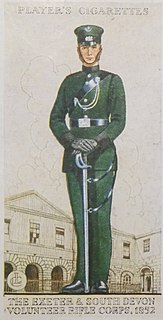 W
WThe Exeter & South Devon Volunteers was the premier unit of Britain's Volunteer Force. Formed in 1852 it went on to become a battalion of the Devonshire Regiment. Both its active service battalions went to garrison India on the outbreak of the First World War, and then saw action in Mesopotamia and Palestine. In the Second World War, the battalion served in the garrison of Gibraltar. It continued in the postwar Territorial Army until it was merged with other West Country units. Its successors today serve in a reserve battalion of The Rifles.
 W
WThe 2nd Welsh Brigade was a Royal Field Artillery unit of Britain's Territorial Force (TF) formed in 1908 that served in Palestine during World War I. Between the wars it converted to the anti-aircraft (AA) role and was captured in Java during World War II. Its successor unit continues in Britain's Army Reserve today.
 W
WThe 1st East Yorkshire Artillery Volunteers was a part-time unit of Britain's Royal Artillery based in the East Riding of Yorkshire, which also contained sub-units from the North and West Ridings. Created during an invasion scare in 1859–1860, it survived to supply units to the later Territorial Force of the 20th century.
 W
WThe 1st East Yorkshire Artillery Volunteers was a part-time unit of Britain's Royal Artillery based in the East Riding of Yorkshire, which also contained sub-units from the North and West Ridings. Created during an invasion scare in 1859–1860, it survived to supply units to the later Territorial Force of the 20th century.
 W
W266 Battery Royal Artillery is a Royal Artillery unit of the British Army Reserve. It was first formed in Bristol in 1859 and served through World War I as field artillery and World War II as anti-aircraft (AA) artillery.
 W
WThe 1st Midlothian Artillery Volunteer Corps was formed in 1859 as a response to a French invasion threat. Originally it served as garrison and heavy artillery but transferred to the Territorial Force (TF) in 1908 as field artillery, in which role it served through both World Wars. In World War I it fought on the Western Front with 51st (Highland) Division. In World War II it briefly saw service in France after Dunkirk and was with Eighth Army in North Africa and Italy. Its wartime duplicate regiment served with distinction in the Burma Campaign. Postwar the regiment continued in existence until amalgamation in 1967.
 W
WThe 1st Newcastle upon Tyne Artillery Volunteer Corps was a unit of the Volunteer Force raised to supplement the British Army at a time of a perceived French threat in 1860.
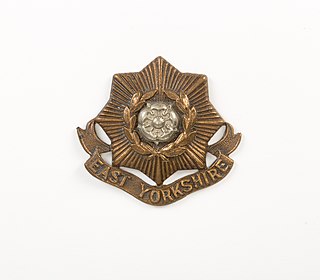 W
WThe Hull Rifles, later the 4th Battalion, East Yorkshire Regiment, was a unit of Britain's Volunteer Force first raised in Kingston upon Hull in 1859. During World War I it served on the Western front, seeing a great deal of action at Ypres, the Somme, Arras, and in the German Spring Offensive, when it was virtually destroyed. Its 2nd Line battalion garrisoned Bermuda for much of the war. During World War II the 4th Battalion was captured at the Battle of Gazala, but its wartime duplicate unit fought on through the Western Desert, Tunisia and Sicily, and then landed in Normandy on D Day. The battalion served in the postwar Territorial Army until 1960, and its successors in today's Army Reserve continue in Hull.
 W
WThe 5th Battalion, King's Regiment (Liverpool) was a volunteer unit of the King's Regiment (Liverpool) of the British Army, part of the Territorial Force (TF).
 W
WThe 5th Battalion, Devonshire Regiment, was a part-time unit of the British Army recruited in the county of Devon. It was formed in the Territorial Force in 1908 by amalgamating two existing Volunteer Battalions of the Devonshire Regiment. The battalion served in India and fought in Palestine and on the Western Front during World War I. In World War II it provided two anti-tank artillery units, which served in Tunisia, Italy and North West Europe. They were both merged into other Devonshire units in 1950.
 W
WThe City of London Rifles (CLR) was a volunteer regiment of the British Army, originally raised as the 'Printers' Battalion'. It saw a great deal of action as an infantry regiment in World War I. During World War II it served in the air defence role, first as a searchlight regiment in the United Kingdom, and later as an anti-aircraft artillery regiment in North West Europe.
 W
WThe 2nd Glamorganshire Artillery Volunteers was a part-time unit of the British Army that defended the coast of South Wales from 1890 to 1942. Although it never saw action in its coastal defence role, it formed several siege batteries of heavy howitzers for service on the Western Front and Italian Front in World War I.
 W
WThe 5th (Cyclist) Battalion, East Yorkshire Regiment was a mobile coast defence unit of Britain's Territorial Force. It was formed in 1908 from a nucleus provided by a Volunteer battalion first raised in 1859. It carried out its defence duties along the East Coast throughout World War I and after the war it was incorporated into a unit of the new Royal Corps of Signals.
 W
WThe 2nd Gloucestershire Rifle Volunteers, was a Volunteer unit of the British Army recruited in Gloucestershire from 1859. After becoming a Volunteer and later Territorial Force battalion of the Gloucestershire Regiment, it fought on the Western Front and in Italy during World War I. Its 1st Line battalion fought a last-ditch defensive action at the Piave and one of its number won a Victoria Cross in the closing weeks of the war. The 2nd Line battalion was involved in an epic rearguard action at Holnon Wood during the German Spring Offensive. In the early part of World War II the battalion distinguished itself at the defence of Ledringhem before being evacuated from Dunkirk. It then served as a unit of the Reconnaissance Corps with 43rd (Wessex) Infantry Division through the campaign in North West Europe. It returned to the Glosters in the postwar Territorial Army until amalgamated with other units in 1967.
 W
WThe 2nd Northumberland Rifle Volunteer Corps, also referred to as the Tynemouth Rifles, was an infantry unit of Britain's part-time force, the Territorial Army. The corps was raised during the expansion of the Volunteer movement in the 1850s and then served with the Territorial Force during the First World War. It converted to an anti-aircraft role just prior to Second World War, and continued to serve until it was amalgamated in 1950.
 W
WThe 5th Battalion, York and Lancaster Regiment, was a unit of Britain's Territorial Force formed in 1908 from Volunteer units originally raised in the West Riding of Yorkshire in 1860. It served in some of the bitterest fighting on the Western Front during World War I, including the Somme, Ypres and the German Spring Offensive. Before World War II it was converted to air defence, in which role it served during The Blitz and in Burma, where it employed anti-aircraft guns for 'bunker-busting'. Postwar, it continued to serve in Anti-Aircraft Command until 1955.
 W
WThe 7th Battalion of the London Regiment was a volunteer unit of the British Army from 1860 until 1961. Recruited from London working men, it sent volunteers to the Second Boer War, saw extensive service on the Western Front during World War I, and defended the United Kingdom as a searchlight regiment during World War II.
 W
WThe Metropolitan Artillery Volunteers was a part-time unit of the British Volunteer Force formed in the London area in 1861. It was designated the 3rd Middlesex Artillery Volunteers and went on to become the 5th London Brigade, Royal Field Artillery in the Territorial Force. It provided two active service units in World War I, which saw action on the Western Front. Just before World War II it again spun off a duplicate regiment, each taking the '5th London' subtitle. Both regiments saw widely varied service during the war. The regiment later provided an airborne artillery unit in the Territorial Army of the 1950s.
 W
WThe Exeter & South Devon Volunteers was the premier unit of Britain's Volunteer Force. Formed in 1852 it went on to become a battalion of the Devonshire Regiment. Both its active service battalions went to garrison India on the outbreak of the First World War, and then saw action in Mesopotamia and Palestine. In the Second World War, the battalion served in the garrison of Gibraltar. It continued in the postwar Territorial Army until it was merged with other West Country units. Its successors today serve in a reserve battalion of The Rifles.
 W
WThe 6th Battalion, Gloucestershire Regimen, was a Territorial Force unit of the British Army. Originally recruited in Gloucestershire as a Volunteer battalion of the Gloucestershire Regiment during the Second Boer War, it fought on the Western Front and in Italy during World War I. In the late 1930s it was converted into an armoured regiment and served as such during and after World War II
 W
WThe 6th Battalion, Royal Welch Fusiliers, was a Welsh unit of the British Army's auxiliary forces. Formed in 1908, from Volunteer units that dated back to 1860, it fought at Gallipoli), in Egypt and Palestine during World War I, and in the campaign in North West Europe during World War II. Postwar it was converted to the anti-aircraft artillery role, then reverted to infantry in 1956 after it amalgamated with a neighbouring unit.
 W
WThe 1st or East Devon Militia, later the 3rd Battalion, Devonshire Regiment, was a part-time military unit in the maritime county of Devonshire in the West of England. The Militia had always been important in the county, which was vulnerable to invasion, and from its formal creation in 1758 the regiment served in home defence in all of Britain's major wars until 1908, after which it became a reserve unit for the Devonshire Regiment.
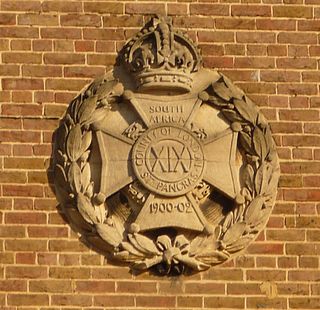 W
WThe 19th Battalion, London Regiment was a Volunteer unit of the British Army in existence from 1860 to 1961 under various titles. A detachment served in the Second Boer War and two full battalions fought in World War I, receiving the surrender of Jerusalem and crossing the Jordan among other exploits. During World War II the regiment operated as a searchlight unit and briefly as an infantry battalion, before becoming an anti-aircraft regiment in the postwar years.
 W
WThe 5th Battalion, Devonshire Regiment, was a part-time unit of the British Army recruited in the county of Devon. It was formed in the Territorial Force in 1908 by amalgamating two existing Volunteer Battalions of the Devonshire Regiment. The battalion served in India and fought in Palestine and on the Western Front during World War I. In World War II it provided two anti-tank artillery units, which served in Tunisia, Italy and North West Europe. They were both merged into other Devonshire units in 1950.
 W
WThe 7th Battalion, Royal Welch Fusiliers, was a Welsh unit of Britain's Territorial Force. First raised in 1897, it fought at Gallipoli and in Palestine during World War I, and in the campaign in North West Europe during World War II. A duplicate battalion was converted to the paratroop role. Postwar the battalion was converted into anti-aircraft artillery, then reverted to infantry in 1956 after it amalgamated with a neighbouring unit.
 W
WThe 8th Lancashire Artillery Volunteers was a unit of the British Volunteer Force raised in Liverpool, Lancashire, in 1860. Later it transferred to the Territorial Force as a brigade of heavy artillery, and its batteries fought in many of the great battles on the Western Front in World War I.
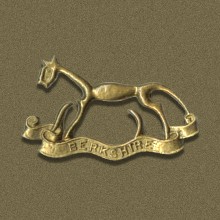 W
WThe Berkshire Yeomanry was an auxiliary regiment of the British Army formed in 1794 to counter the threat of invasion during the French Revolutionary Wars. It was the Royal County of Berkshire's senior volunteer unit with over 200 years of voluntary military service. After taking part in the Second Boer War, it saw action as mounted troops in the First World War and as artillery in the Second World War. Its lineage is maintained by 94 Signal Squadron, part of 39 (Skinners) Signal Regiment. The Headquarters of the Squadron is based in Windsor, Berkshire. The Berkshire Yeomanry had a number of battle honours won from Europe to the Far East and Private Frederick Potts was awarded a Victoria Cross for service during the Gallipoli Campaign.
 W
WThe City of London Yeomanry was a yeomanry regiment of the British Territorial Army, formed in 1901 from veterans of the Second Boer War. In World War I it served dismounted in the Gallipoli Campaign but reverted to the mounted role in the Senussi campaign, at Salonika and in Palestine. It ended the war as a machine gun unit on the Western Front. In the interwar years it was reduced to a battery in a composite Royal Horse Artillery unit in London, but in the period of rearmament before World War II it was expanded into a full regiment of light anti-aircraft artillery. It served in this role during The Blitz and later in the Tunisian and Italian campaigns. Postwar it became an armoured regiment. It amalgamated with the Inns of Court Regiment to form the Inns of Court & City Yeomanry in 1961. The lineage is maintained by 68 Signal Squadron, part of 71 (Yeomanry) Signal Regiment.
 W
WThe 130th Brigade, originally the Plymouth Brigade was an infantry formation of Britain's Volunteer Force, Territorial Force, and later Territorial Army (TA). In World War I the brigade was in British India for most of the war and did not see service as a complete formation, but many of its battalions fought in the Middle East campaigns. The brigade did see action during the campaign in North West Europe of World War II, distinguishing itself at actions such as Operation Jupiter, the capture of Mont Pinçon, Operation Market Garden, at 'Dorset Wood' and at Hengelo. As 130 Brigade it continued in the postwar TA until 1961.
 W
WThe Glamorgan Yeomanry was a Yeomanry regiment of the British Army originally raised in the late eighteenth century as a result of concern over the threat of invasion by the French. It was re-raised in the Second Boer War and saw service in both World War I and World War II. The lineage is maintained by C Troop, 211 Battery, 104th Regiment Royal Artillery.
 W
WThe Hampshire Yeomanry was a yeomanry cavalry regiment formed by amalgamating older units raised between 1794 and 1803 during the French Revolutionary Wars. It served in a mounted role in the Second Boer War and World War I, and in the air defence role during and after World War II. The lineage is continued by 295 Battery and 457 Battery, batteries of 106 (Yeomanry) Regiment Royal Artillery, part of the Army Reserve.
 W
WThe Middlesex Yeomanry was a volunteer cavalry regiment of the British Army originally raised in 1797. It saw mounted and dismounted action in the Second Boer War and in World War I at Gallipoli, Salonika and in Palestine, where one of its officers won a Victoria Cross at the Battle of Buqqar Ridge and the regiment rode into Damascus with 'Lawrence of Arabia'. Between the world wars the regiment was converted to the signals role and it provided communications for armoured formations in World War II, including service in minor operations in Iraq, Palestine, Syria and Iran, as well as the Western Desert, Italian and North-West European campaigns. It continued in the postwar Territorial Army and its lineage is maintained today by 31 Signal Squadron, Royal Corps of Signals, which forms part of the Army Reserve.
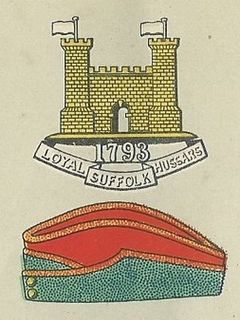 W
WThe Duke of Yorks Own Loyal Suffolk Hussars was a Yeomanry regiment of the British Army. Originally formed as a volunteer cavalry force in 1793, it fought in the Second Boer war as part of the Imperial Yeomanry. In the World War I the regiment fought at Gallipoli, in Palestine and on the Western Front. The unit was subsequently converted into a Royal Artillery unit, serving in the anti-tank role North Africa, Italy and France during World War II. The lineage is maintained by No. 677 Squadron AAC.
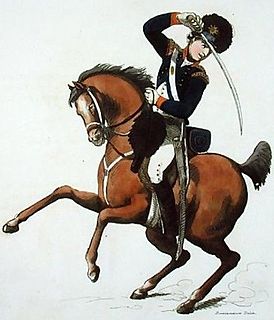 W
WThe Yeomanry Cavalry was the mounted component of the British Volunteer Corps, a military auxiliary established in the late 18th century amid fears of invasion and insurrection during the French Revolutionary Wars. A yeoman was a person of respectable standing, one social rank below a gentleman, and the yeomanry was initially a rural, county-based force. Members were required to provide their own horses and were recruited mainly from landholders and tenant farmers, though the middle class also featured prominently in the rank and file. Officers were largely recruited from among the nobility and landed gentry. A commission generally involved significant personal expense, and although social status was an important qualification, the primary factor was personal wealth. From the beginning, the newly rich, who found in the yeomanry a means of enhancing their social standing, were welcomed into the officer corps for their ability to support the force financially. Urban recruitment increased towards the end of the 19th century, reflected in the early 20th century by increasingly common use of hired mounts.